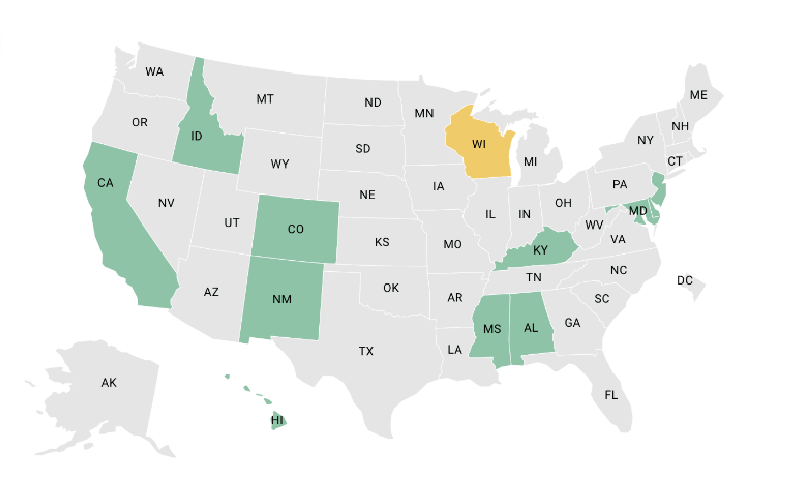Section 1 of the RAISE Act State Policy Roadmap for Family Caregivers
This is the first section of the RAISE Act State Policy Roadmap for Family Caregivers. The goal of this publication is to provide a roadmap for state officials to better understand the state policy landscape for supporting family caregivers of older adults and to identify opportunities for innovation in their own states.
This roadmap was made possible by support from The John A. Hartford Foundation and the RRF Foundation for Aging.
Rationale for Building Awareness of Family Caregiver Supports
“Family caregivers are the greatest asset to the Medicaid program.”
— Oregon state aging and disability policy leader, NASHP 2020 conference
Family caregivers are crucial supports to some of the states’ most vulnerable populations, including those who were most affected by the coronavirus. The stress of caretaking is increasingly recognized as a critical issue to state policymakers because:
- State Medicaid programs cover six of every ten of the country’s nursing home residents, with combined federal and state Medicaid home and community-based spending totaling $92 billion in 2018. This expenditure is expected to increase as the US population ages.
- State Medicaid programs serve as the de facto long-term services and supports safety net for older Americans, including middle class families who spend down assets.
- Having engaged family caregivers with supports can delay the need for nursing home care, reduce hospitalizations, and lower an individual’s overall risk for nursing home placement.
- State budget and policy ramifications of an aging population cannot be addressed without also understanding the needs of family caregivers.
State Challenges
While states have good reasons to reach out to family caregivers, many of them do not have the resources to do so. In spring 2020, NASHP partnered with ADvancing States to conduct a listening session with state aging and disability agency officials for feedback on state family caregiver supports. About 40 percent of participants reported that they do not have a marketing strategy to raise awareness of services for family caregivers. Most of the states that do not provide awareness education shared that it is due to limited resources; with so few services available for caregivers, officials did not want to spend funds advertising that they could provide services.
Yet, according to findings from an Administration for Community Living (ACL) Request for Information — which received more than 1,600 responses —”[…] to access supportive services directed at the caregiving population, family caregivers need to identify as such. Thus, increasing public awareness of the caregiving role was seen as an important need.”
In other words, family caregivers often may not self-identify as “family caregivers,” but rather as a son, daughter, or friend. Family caregivers who do not identify as such may not be aware that services are available to them. Additionally, findings from a series of NASHP-supported listening sessions found that family caregivers from communities of color or immigrant communities report being underserved due to linguistic barriers and a lack of awareness.
In spite of these challenges, many states are moving forward with state policy and programs to engage and support family caregivers.
Recommendations and State Strategies
RAISE Family Caregiving Advisory Council Recommendations
Goal 1: Family caregivers’ physical, emotional, and financial well-being will improve as a result of expanded awareness, outreach, and education.
1.1: Increase public awareness and recognition of the diverse needs, issues, and challenges family caregivers face and of the importance of recognizing and supporting them.
1.2: Increase family caregivers’ self-identification and awareness of, and access to, information, services, and supports across a range of topics.
1.3 Improve outreach efforts to family caregivers to ensure early identification and access to services and supports.
1.4: Support the development, or revision of, state, territorial, Tribal and local planning that focuses specifically on recognizing, including, and supporting family caregivers of all ages and is aligned with the National Family Caregiving Strategy.
1.5: Promote the expansion and role of public/private partnerships at all levels that recognize, assist, include, support and engage family caregivers.
States can play a critical role in implementing the above five recommendations to support public education and awareness around family caregiving, through the following strategies.
Launching public outreach campaigns for family caregivers
Public outreach campaigns to promote caregiving services and reach caregivers in the community can help people better understand the services and supports available to help them in their caregiving roles.
Minnesota and Washington: Outreach to Caregivers
The state of Minnesota awarded a nonprofit organization, the Amherst H. Wilder Foundation, a state grant to expand a caregiving outreach campaign statewide. The Amherst H. Wilder Foundation, located in Minnesota, first received a grant from a charitable foundation to launch a campaign to raise community awareness of caregiving in St. Paul, MN, and then received state funding to expand the outreach campaign statewide. The caregiving awareness campaign used multiple modes of outreach, including bus advertisements, radio, social media, and print advertisements. The campaign also incorporated engagement and outreach in libraries, pharmacies, and at community events; and print media such as posters and brochures. The campaign led to the engagement of faith communities in supporting caregivers, and public service announcements on local public television. The Wilder Foundation reports the campaign received more than 170 million media impressions since 2011.
Building on the success of the campaign in Minnesota, in 2017, The Wilder Foundation partnered with the state of Washington to adapt the materials in support of Washington’s family caregiving campaign. See the photos below of bus and bus shelter ads, billboards, posters, rack cards, and brochures.
As part of this effort, Washington State created educational place mats that can be used at senior centers and other meal sites:
In 2015 the Minnesota Board on Aging created a media outreach campaign in partnership with local area agencies on aging, public media outlets, providers, and community members for new immigrants on caring for older adults. The campaign included informational videos produced in Cambodian, English, Hmong, Somali, and Spanish. Minnesota currently is developing a tribal caregiver education badge based on interviews and collaboration with tribal communities.
New York: Outreach to Employers
In 2021, New York launched a campaign targeting businesses in the state to support outreach to employed caregivers. The campaign includes a survey to businesses and employees and outreach materials (see below). The purpose of the campaign is to raise awareness about working caregivers and services available, and to help working caregivers connect to these supports while measuring their caregiving experience. The campaign also aims to help caregivers navigate potential challenges they face in balancing their work and family lives.
This campaign was developed in partnership between the New York Office for the Aging, the Department of Health, and the Department of Labor, working with the Association on Aging in New York representing the state’s area agencies on aging. The partnership also engages with the national family caregiving company, ARCHANGELS, allowing caregivers to use the Caregiver Intensity IndexTM online platform.
New York Outreach Materials for the Employed Family Caregivers Campaign
- An outreach factsheet, with facts and statistics on New Yorks working caregivers
- A new state publication, the Resource Guide for Businesses,to identify working caregivers and link them to community services
- “Caregiver Intensity Index”, provided by ARCHANGELS, for working caregivers to engage caregivers, assess the intensity of their experience, and connect them to resources
- Statewide Employed Caregiver Survey, collecting data on the number of working caregivers and tasks they perform
Research has found that approximately 60 percent of family caregivers are employed outside of the home. Targeting employed family caregivers, the state noted that:
- 69% of working caregivers report having to change or adapt their work schedule to meet caregiving responsibilities
- 75 percent of people trust their employer, noting employees may be more likely to use information about caregiving provided through their employer
As states implement new paid and family leave benefits supporting caregivers, they have an opportunity to develop and promote similar educational campaigns to employed caregivers.
Wisconsin: Customized Caregiver Materials and Toolkits
The Wisconsin Department of Health Services publishes materials for caregivers on its state website and on WisconsinCaregiver.org. Wisconsin collaborated with the private company TRUALTA to develop a training and education website. The Greater Wisconsin Agencies on Aging Resources (GWAAR), a private nonprofit organization and AAA that receives funding through the Older Americans Act, supports caregivers by creating marketing materials for counties and tribes, compiled in the Wisconsin Family Caregiver Marketing Toolkit. Materials include customizable fact sheets and brochures to educate caregivers on available programs and learning opportunities in local communities. The Wisconsin Department of Health Services also maintains a Dementia-Friendly Employers Toolkit which provides resources for employers and employees.
Learning from Caregiver Outreach During COVID-19
States used their aging and disability resource centers to support caregivers via outreach during the pandemic by quickly utilizing technology when in-person contact was impossible. New Hampshire and Colorado outreached to family caregivers to assess pandemic-related needs and impact. New Hampshire offered a pandemic-specific self-care series for caregivers, Supporting Caregivers During COVID. Colorado incorporated virtual caregiver respite, including packages with self-care resources and opportunities for caregivers to connect through Zoom.
Source: U.S. Administration for Community Living, State Strategies For Supporting Caregivers handout
Specifying support targeted to family caregivers in regulation, manuals, and other planning documents
States receive federal funding for National Family Caregiver Support Program (NFCSP) activities through the Older Americans Act. States can enhance federal programmatic requirements to bolster outreach to families who may benefit from these programs. NFCSP grant funding is required to be used for providing information about available services to caregivers, assistance in gaining access to services, respite, counseling, support groups and caregiver training, and to a limited extent, supplemental services.
Delaware, Vermont, and Wyoming: Requirements on Outreach
States can define outreach activities in family caregiving program regulations and manuals, including information on the number of outreach events an organization must complete; the locations or populations that should be targeted; and types of media to utilize.
- Delaware’s Caregiver Resource Center service specifications include information on outreach approaches; requirements for Caregiver Resource Centers around marketing strategies and community outreach; and data collection requirements around outreach.
- Vermont’s Older Americans Act Policy and Operations Manual details requirements of outreach to caregivers through activities such as publicity campaigns, broadcast media outreach, outreach in faith communities, and developing workshops in senior communities.
- Wyoming’s National Family Caregiver Support Program Policy and Procedures specifies that grantees conduct outreach including presentations to group organizations and health fairs, newsletters, and promotion and public education through broadcast and print media.
Caregiver Outreach Measurement in Delaware
Delaware collects data from Caregiver Resource Centers on the amount of outreach they conduct, including the number of caregiver trainings, support groups, outreach events, conferences, and expos attended; and the amount of media outreach conducted, including the number of newspaper articles per month, senior center newsletters, flyers, program notices, and public service announcements.
Building state plans on aging that include family caregiver supports
These efforts and documents can draw needed attention to family caregivers and public policy solutions.
California: Master Plan for Aging
In June 2019, California Governor Gavin Newsom issued an executive order calling for the creation of a Master Plan for Aging. Released in January 2021, the Master Plan for Aging outlines 5 goals and 23 strategies to build a California for All Ages by 2030. It also includes a data dashboard to measure state progress.
One of the Master Plan for Aging’s goals — Caregiving That Works — notes three strategies to support caregiving:
- Support for friends and family who are caregivers;
- The development of high-quality caregiving jobs;
- Expanding options for virtual care
The target for the caregiving goal is to create one million high-quality direct care jobs; paid caregiving is essential for many family caregivers, who rely on support from direct care workers.
Indiana: State Plan on Aging
Indiana’s state plan on aging for federal fiscal years 2019-2022 includes a goal of supporting caregivers’ ability to provide ongoing informal supports. The goal includes a key objective of increasing awareness around caregiving. To accomplish this objective, the state plan on aging lays out the following state strategies:
- Create and promote a comprehensive resource site for family caregivers, including links to training resources, on Indiana’s www.INconnectAlliance.org website.
- Work with stakeholders such as the governor’s Commission on Aging, Long Term Care Transformation Workgroup, area agency on aging and aging and disability resource network, and more to create a short-term task force to create and implement a statewide plan on caregiving.
- Increase awareness of existing long-term services and supports, such as Older Americans Act Title III-B personal care, homemaker, adult day services, etc., which serve as supports for caregivers.
Measures to mark progress include:
- Establish a baseline and methodology for website analytics related to the INconnect Alliance website caregiver resource page and develop targets based on baseline information.
- Establish baseline and targets for increase in number of caregivers of older adults and older relatives caring for children served through the Older Americans Act Title III-E program.
- Complete a review of Title III-E programming with recommendations for enhancements.
- Implement strategies identified in review of Title III-E programming.
- Demonstrate improvements in caregiver self-efficacy.
The state plan on aging laid out strategies including but not limited to promoting a resource site for family caregivers, and increasing awareness of existing supports, including Older Americans Act Title III-B supports, that could support caregivers. The state plan also noted progress measures, including but not limited to the development of a baseline and methodology to measure website analytics for a caregiver resource page; and development of a baseline and targets for increasing the number of caregivers served by Older Americans Act Title III-E supports.
The Division of Aging developed a caregiver survey to better understand what supports are needed for aging individuals. This survey was developed through WISE Indiana (Wellbeing Informed by Science and Evidence in Indiana), a partnership between the Indiana Clinical and Translational Sciences Institute’s Monon Collaborative and the Indiana Family and Social Services Administration to engage Indiana’s nationally-recognized academic experts to evaluate and inform Indiana practices, programs and policies. The caregiver survey will be administrated through the end of 2021. The Division of Aging will be leveraging partnerships with community-based organizations to conduct outreach. Additionally, the Division of Aging will review survey results with stakeholders to determine how to address unmet needs.
Creating and engaging state family caregiving task forces and councils
Governors and/or state legislators can create task forces to raise awareness, examine family caregiver needs, identify service gaps, and develop recommendations. Twelve states have developed task forces on family caregiving between 2014 and 2019.
State Task Forces on Family Caregiving
This map features state initiated/sponsored task forces that focus on caregivers of older adults. States and non-government organizations have created additional task forces and other initiatives focusing on caregivers of children.
New Mexico: State Legislation Creating Taskforce and Outreach Materials
In 2004, the state legislature enacted House Joint Memorial 4 to request that the Aging and Long-Term Services Department establish a taskforce to create a state plan for addressing the challenges faced by family caregivers. The taskforce researched available policies, resources and innovative support; interviewed caregivers about their needs, compiled an inventory of resources available to caregivers, and identified legislative and administrative actions to support caregivers. As a result, New Mexico created the Caregiver Resource Center and the Healthy Aging Initiative in 2016, published a Caregiver Resource Handbook, and created a caregiver support page and a respite guidance page through the Department of Health.
Wisconsin: Governor’s Task Force on Family Caregiving
In February 2019, Wisconsin Governor Tony Evers issued Executive Order 11, creating a task force on family caregiving. The task forces responsibilities included preparing recommendations on supporting family caregivers, expanding the pool of providers, creating a registry of home care workers, expanding respite services, and providing compensation for family caregivers. In September 2020 the task force submitted a report of findings, which included 16 recommendations. The Governor proposed more than $600 million to implement long-term care infrastructure and direct care workforce support, incorporating task force recommendations, in the 2021-2023 proposed budget. Not all task force recommendations were approved by the state legislature, but opportunities to address more recommendations may exist using American Relief Plan Act funding.
Wisconsin has also been developing resources to help Aging and Disability Resource Center (ADRC) staff support and ease transitions for family caregivers after the person they care for is placed in a facility or dies. The state and its partners recognize that family caregiver responsibilities do not end when daily hands-on care end. Caregivers continue to benefit from receiving support while handling post-death financial issues, grief and the life changes that come after a life partner or other significant person is gone.
The Wisconsin Family and Caregiver Support Alliance (WFACSA), of which the Wisconsin Department of Health Services is a member, plays a significant role in researching and formulating policy ideas for Wisconsin caregivers of all kinds. WFACSAs current goals, objectives and projects can be viewed here.
Lessons Learned from State Awareness and Outreach
- Work across agencies and systems to leverage scarce resources.
- Pay attention to messaging: avoid the word “caregiver” and instead use phrases that describe caregiving.
- Collaborate with private and local entities to get out the word about family caregiving.
- Target outreach to employed family caregivers, especially when rolling out educational materials about leave benefits.
- Use cultural sensitivity and translate materials into non-English languages to target messaging and services to underserved populations.
- Revisit state planning documents and consider state taskforces, which can advance attention to and awareness of caregivers.
- Think about sustainable funding; local funding and charitable foundations as well as new American Rescue Plan Act funding are potential sources.
About This Roadmap
The purpose of this roadmap is to support states that are interested in developing and expanding supports for family caregivers of older adults by offering practical resources on identifying and implementing innovative and emerging policy strategies. Although families care for people across the lifespan, the focus of this roadmap is on policies, programs, and funding for family caregiver of older adults.
NASHP created this roadmap with guidance from policymakers and leaders from across state government, using the RAISE Act goals and recommendations as a framework. Congress enacted the Recognize, Assist, Include, Support and Engage (RAISE) Family Caregivers Act in 2018, which created an advisory council to develop the country’s first national Family Caregiver Strategy. With support from The John A. Hartford Foundation and in coordination with the U.S. Administration for Community Living, NASHP’s RAISE Family Caregiver Resource and Dissemination Center aims to support states as they develop policies to address family caregivers.
The RAISE Family Caregiving Advisory Council recently published its five goals and 26 recommendations which highlight ways that states can better support family caregivers. In alignment with the Council’s work, the roadmap is organized into the following sections as a series:
Section 1: Public Awareness and Outreach to Family Caregivers
Section 2: Engagement of Family Caregivers in Healthcare Services and Systems
Section 3: Services and Supports
Section 4: Financial and Workplace Security for Employed Family Caregivers




